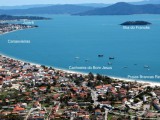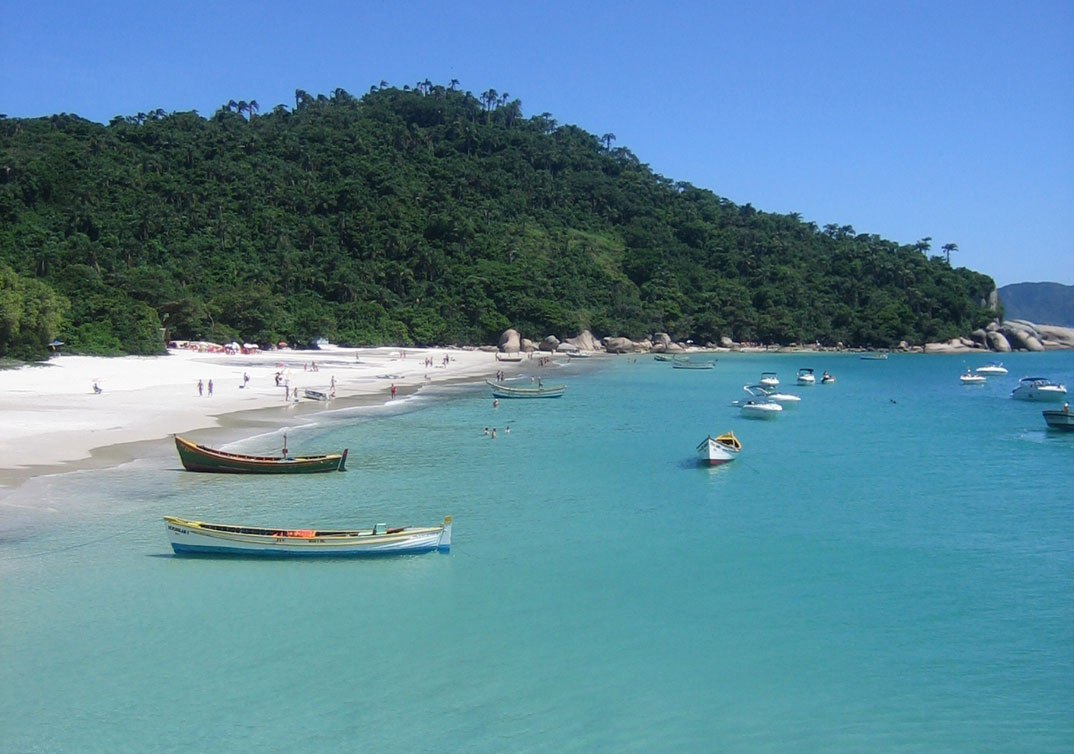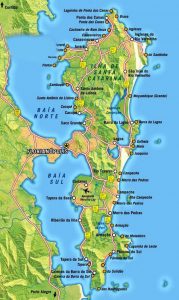Este post também está disponível em:
Português
English

The island of Santa Catarina is part of the municipality of Florianópolis and is located in the Atlantic Ocean, on the southern coast of Brazil, in the center of the coastline of the state of Santa Catarina.
It is about 54 km long (north-south) by no more than 18 km wide (east-west) to the north, totaling an area of 424.4 km².
In the smallest state of the southern region, Florianópolis does the magic of multiplying destinations. A single city attracts those who want beach or rural landscapes, ecotourism or night clubs, surfing, horseback riding or extreme sports.
View the map of Santa Catarina Island
Its exuberant landscapes turn it into a quiet place for families with children, romantic for honeymooners and even liberal for the GLS public.
It has accommodations for any income range: from the paradisiacal resort to the fisherman’s house rented by groups of friends who spend the best part of their vacation there.
Watch the videos about Santa Catarina Island and Florianópolis.


Florianópolis Guia Turismo

Florianópolis Vista Aéria

Praia do Campeche em Florianópolis03:36

8 passeios incriveis em Florianópolis05:11
Among the Brazilian capitals, only Rio de Janeiro is equal to Florianópolis in the diversity of natural beauties, in the concentrated set of mountains, sea, lagoons, dunes, Atlantic Forest, sandbanks and mangroves.

It is no wonder that a large part of the tourists, national or foreign, are repeat visitors: they visit and come back.
Sometimes, they come back to live. Especially because, considering the 42 official beaches, urban to the north and wild to the south, the list of attractions – cultural, gastronomic, etc. – is practically inexhaustible.
With 400,000 inhabitants, the city starts on the mainland and takes in the immense island of Santa Catarina, which is about 60 km long. Distances are long, therefore, from one beach to another, and traffic jams are frequent in the summer months.
Canasvieiras, for example, is 27 km from the center, to the north, while from the center to Armação or Matadeiro, at the southern tip, it is 22 km.
Public transport is efficient, the lines are interconnected with a single ticket, but the transfers at terminals make travel time-consuming, from south to north, or from the extremities to the center.
The center is worth a visit: there are the centenary Public Market, the giant fig tree in Praça 15 and the sobrado, now a museum, where the Santa Catarina painter Victor Meirelles lived, author of the canvas ‘The First Mass of Brazil’, from 1861.
At the heart of the treasure map, the blue spot stretching north is Lagoa da Conceição, a formidable leisure center: boat trips, water sports, bars, restaurants, discos, stores, handicrafts.
Once upon a time, in the era before digital cameras, 36-poster films ended halfway up the coast at Costa da Lagoa, a village with alternative architecture and habits, including no land transportation.
The thick green hills show rocks, bromeliads, cacti, gleaming yellow ipês, the alleys called servidões, the small wharves where the residents embark and disembark.
It is one of those special places in the world that make urbanites rethink their entire way of life in a few seconds, such is the visual impact.
The surfers’ mecca, Joaquina, and Praia Mole are neighbors of Lagoa.
From Mole, with its cool tents and high waves, you can walk to Galheta, the only naturist beach in Floripa. Relaxed naturism, without inspectors, without the stress of the obligation to be naked.
The enclaves of calm and warm (or less cold) waters line up to the north: Jurerê, Canasvieiras, Ponta das Canas and Lagoinha, facing the mainland. They are areas with a large structure of accommodation and residential condominiums, and also a favorite place for Argentine tourists.
“Canasvieiras is in the Malvinas”, as the writer Marcelo Mirisola made clear.
In the last decade, Jurerê’s waterfront has become synonymous with growing sophistication, with day clubs, international menus, sophisticated soundtracks, cushions in Arabic tents and an intoxicating typical drink: sparkling wine. Sparkling wine every day, every hour, before and after diving, lunch, supper.
The culture of the Azorean colonization thus pays its respects to French daily life, to the north and to the south. To the south is Campeche beach, whose main avenue, the Pequeno Príncipe, pays homage to the writer Antoine de Saint-Exupéry, who among other feats fixed the air route to Patagonia. In 1931, when he was head of the Aeropostale company in Buenos Aires, Saint-Exupéry landed in Campeche.
The book “The Little Prince” even raises the ball of the inhabitants of Florianópolis: the lamp-lighters are the fishermen who, worried about that flying machine, made trails of lights so that the aviator could find the landing strip.
For some decades now, therefore, the south of the island has been a special place, generous to outsiders. It’s quieter, more rustic, almost a rural area, with grazing herds and all, with a cold sea nearby.
The best trails leave from or pass through Pântano do Sul, famous for Bar do Arante, which collects thousands of little notes hanging from the ceiling and walls. They are impressions from various eras, from visitors from Brazil and around the world, about the landscapes, the food, the drinks, the natives of the coast, which is among the privileged in the country.
Try to set aside at least a week for Florianópolis if you’re going for the first time. The boat trips to the colonial fortresses and Campeche Island alone take a full day each. Don’t forget that the South is not the Northeast: it’s only hot in spring and summer, from September or October until March or early April.
And come back: to your favorite bistro, to the new dance floor, to learn canoeing or windsurfing on the Lagoa. The printed map of Florianópolis, with its reliefs, recesses and coves, is already worthy of hanging on the wall. Seeing the map live is worth popping a sparkling wine cork.
Santa Catarina Island Tourism Guide



















